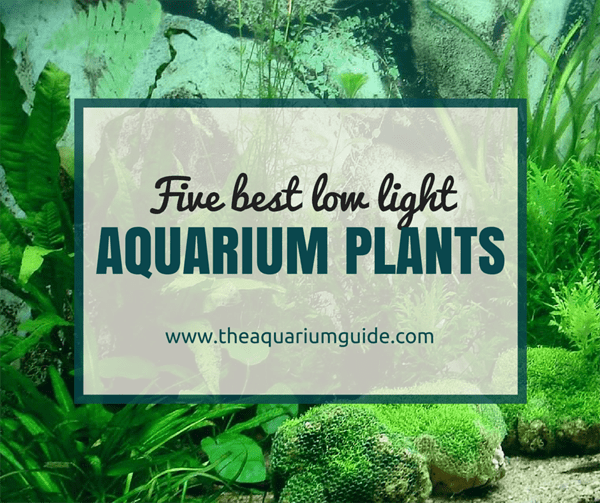
What are low light plants and what can they do in your aquarium? They are often referred to as the “easy plants” as they are very easy to maintain and they can thrive in low light aquariums.
Usually used as an underwater decoration and a hideaway for fish, these low-light aquarium plants do not need extra lights, specific water regulations, or even CO2 to survive.
Table of Contents
Low Light Aquarium Plants
1. Java Moss
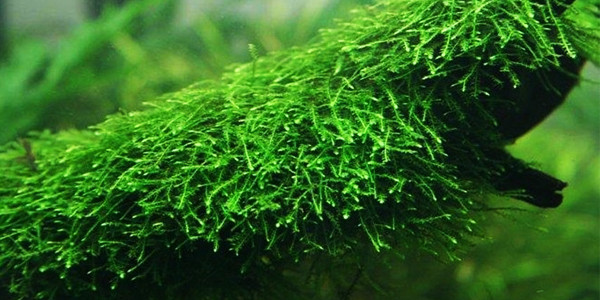
This adaptable moss is capable of enduring difficult conditions and can attach itself to any object. Using string, staples, or pins, you can connect it to a cork or a foam background if you want.
It can grow in low light and will create a living wall for your aquarium where fish can play and eggs can hatch peacefully.
You need to trim your Java Moss occasionally though to prevent overgrowth and to keep your tank looking beautiful. To know more about Java Moss, you can read my previous post – Java Moss: What You Should Know?
2. Anubias
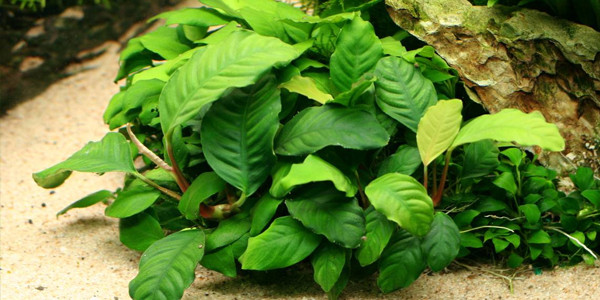
An Anubias is a semi-aquatic flowering plant that can usually be found in streams, rivers, and marshes and it originates from the vast African jungle streams.
They are extremely adaptable to a variety of shades and irregular rising and falling of water levels.
They do not only require low maintenance and low light, but they are great for a beginner’s aquarium. These types of plants will attach themselves to driftwood if you have it in your tank.
Always cut the leaves of the Anubias and remember to trim your plant for the best growth result.
3. Java Fern
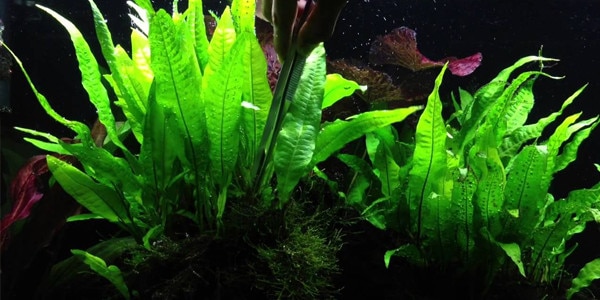
There are six species of Java Fern that can be identified by their leaves; some have short leaves and others have wide leaves, or you may find some with long, thin leaves and others with very detailed, lacy, branching leaves.
In the wild, these aquatic ferns normally grow along the edges of rivers, waterfalls, and rocks.
Using a cotton thread, you can attach the fern to ornaments, rocks, and driftwood. They adapt very well to low light and do not require a lot of maintenance to keep them looking beautifully complex.
4. Vallisneria
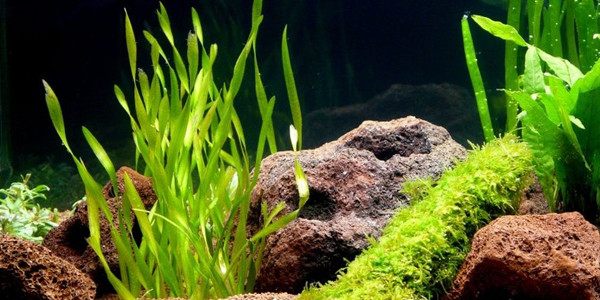
A Vallisneria is a freshwater aquatic plant, which some people call eelgrass, and is used at the sides or back of a tank to frame the rest of the aquarium.
Vallisneria is an underwater plant that grows by runners and often forms a tall underwater meadow, shading out other plants. Leaves will grow in clusters from the roots.
They can be identified by their interesting leaves that have raised veins and round tips.
They are very adaptable and will grow under low light but at a slower rate. As soon as they get “comfortable” with their surroundings, the female flowers will then grow to the surface on very long stalks.
A male flower, however, grows on shorter stalks and can become detached to float to the surface. They bear fruits that are banana-like capsules with a lot of tiny seeds.
5. Sagittaria
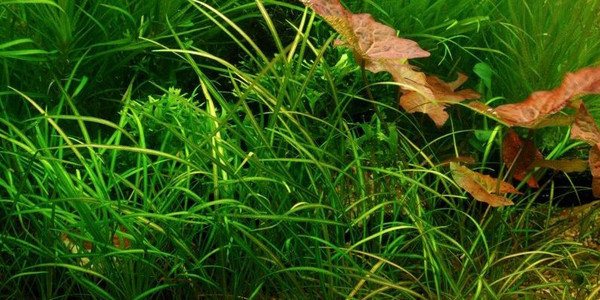
Sagittaria is an ascendant of about thirty species of aquatic plant, most of them known as duck potato, arrowhead, Katniss, Kuwait, Tule potato, Swan potato, and Wapato.
They are bright green, grass-like plants that can make a beautiful background, foreground, or mid-ground depending on the species.
Growing in rosettes, they will send off a runner that will generate a new plant. Their bright green clumps work well in color and give great form with other aquatic plants.
6. African Water Fern (Bolbitis heduelotii)
Ferns are a staple when it comes to home décor. However, did you know that the same is available for the aquariums too? The plant is native to the Congo River Basin and can grow up to 22 inches in height. So, they are ideal for medium to large tanks.
They are ideal for freshwater tanks and need slightly warmer water temperatures for optimal growth. Although the overall care isn’t complicated, planting it the right way is key. You need to plant it in the bottom and secure it well to free float.
Ideally, the plant is kept tied to a rock or driftwood in the tank using a fishing line or another kind of waterproof thread to ensure enhanced durability.
| Light level required | Low |
| Level of care | Easy |
| Compatibility | Medium to large tanks |
7. Green Hygro (Hygrophila polysperma)
Another staple yet easy to care for aquarium plant that thrives in low light is the Green Hygro. They are ideal for freshwater tanks and can sustain a lot.
The plant does grow brown in parts, especially the leaves submerged under the bottom. The easiest way to fix that is by cutting off the browning leaves. Doing so will encourage regrowth of the leaves plant growth of the plant.
The plant relies on the water column for nutrition. So, you can use any kind of substrate to plant it in.
| Light level required | Low |
| Level of care | Easy |
| Compatibility | Freshwater tanks |
8. Hornwort (Ceratophyllum demersum)
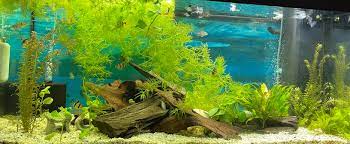
Adding Hornwort to the aquarium is the best way to spruce it up. The unique appearance of this plant makes it stand out in the fish tank and adds a touch of new to the look. The only downside to this is that it grows super fast.
The plant can easily grow up to 10 feet when fully mature. So, you need to consistently trim the ends and clean up the edges from time to time. However, hornwort is very hardy and won’t give you a hard time managing it.
You can tie it down to the substrate for quicker growth. Also, it needs a normal water temperature to thrive in.
| Light level required | Low |
| Level of care | Easy to intermediate |
| Compatibility | Larger tanks |
9. Rotala Rotundifolia
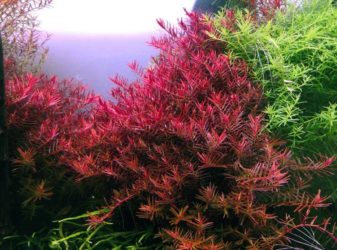
As difficult as the name is, Rotala Rotundifolia is an equally beautiful aquarium plant. The bright red contrasts well with the glass and the darker substrate in the bottom. It is a water column feeding plant, so you won’t have to worry about rooting it to the substrate.
The plant is ideal for beginners, especially ones who don’t have access to larger tanks. The plant grows in low nitrate levels, so be mindful of that. Also, it needs a low to moderate light setting for growth.
It can adapt itself to the different water temperatures, making it thrive for days and months to come. Rotala Rotundifolia requires consistent trimming, so be ready with a pair of trimmers every few days.
| Light level required | Low to moderate |
| Level of care | Easy |
| Compatibility | Medium to large tanks, freshwater |
10. Parrots Feather (Myriophyllum aquaticum)
The combination of green and hues of blue is what gives it its name. The plant needs to be anchored to the bottom since it doesn’t solely depend on the water column for nutrition.
Also, since the plant has widespread foliage with a dense bush-like appearance, it often acts as a hiding spot for the small, vulnerable fish species. The substrate should be treated with fertilizer from time to time to ensure optimal growth. Parrot’s feather grows well in the fine-grain substrate.
| Light level required | Low |
| Level of care | Easy to intermediate |
| Compatibility | Freshwater tanks that need hiding spots |
11. Rotala Indica
Taking care of Rotala Rotundifolia can be a little confusing for beginners. So, what you can do is start with Rotala Indica. It is beginner-friendly and has a unique appearance that stands out in any aquarium.
The needle-like leaves have a bright green color and add a pop of color to the tank you keep in. It is a column feeding plant but often gets its nutrition from the substrate. Besides the consistent growth, the plant is sensitive to a few factors, especially light and temperature. So, be mindful of the same.
| Light level required | Low to moderate |
| Level of care | Easy to intermediate |
| Compatibility | Freshwater tanks |
12. Moneywort (Bocapa Monnieri)
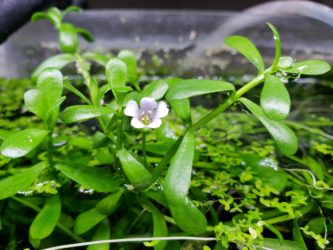
Unlike the money plant you have in your home, Moneywort is completely different. This doesn’t grow very tall and up to a maximum height of 12 inches. So, it is not a question that it works well with smaller tanks.
The low to moderate light setting works great for this plant, and it can also extend above the water, which is always a benefit. The leaves are dense and thick and have a rounded shape to them. As for the nutrition supply, it gets it from the water column.
Ideally, moneywort is a very common addition to the home aquariums because of the ease of care. You don’t need to meddle around with it. Also, it doesn’t require frequent trimming, which is beneficial too.
| Light level required | Low to moderate |
| Level of care | Easy |
| Compatibility | Smaller tanks |
13. Cryptocoryne Wendtii
Often known as crypt wendtii, this is another popular type among beginner aquarists. Although quite easy to care for, the plant mimics the behavior of the fish. It needs stable water conditions throughout. Any sudden changes to the temperature and pH will kill the plant.
The leaves in the plant grow quite long and hence need low light conditions to thrive. Just the leaves alone can grow up to 18 inches. When planting it initially, you need to check the water parameters. It takes a little time to acclimatize itself to the water, so you need to be mindful of that.
| Light level required | Low |
| Level of care | Easy to intermediate |
| Compatibility | Tanks with higher grain substrate |
14. Brazilian Pennywort (Hydrocotyle Leucocephala)
This is an OG aquatic plant for the tanks that you will more or less find in every home. The flat rounded leaves add a beautiful look and appearance to the tank and bring out its beauty. They grow as creeping vines, so make sure you tie its path.
With proper lighting and nitrogen levels, the plant can grow alarmingly quickly. Also, it needs a warmer temperature and works well in tropical freshwater tanks. Some aquarists leave it free-floating on the surface because of how good it looks.
The best thing about this aquarium plant is its versatility. It grows well while free-floating and also while rooted to the bottom. Just ensure that the leaves stay vibrant green and don’t lose their color.
| Light level required | Low |
| Level of care | Easy |
| Compatibility | Freshwater tanks |
15. Cryptocoryne Balansae
Another unique plant that you can consider investing in is this one. The broad, fingered leaves add a beautiful appearance to the tank, which is a pretty convincing reason why your tank needs it.
The plant ideally grows in high light conditions. However, the high adaptability rate of this plant makes it ideal for low light conditions too. To ensure optimal growth, you need to tie it down well to the bottom and the substrate. Also, the plant can grow up to 3 feet in length, which makes it an ideal choice for small to medium tanks.
The runners around the side need to be trimmed from time to time. So, be prepared for that commitment every few days or weeks.
| Light level required | Adaptable to low light conditions |
| Level of care | Easy |
| Compatibility | Small to medium tanks |
16. Cryptocoryne Usteriana
Another crypt variant that stands out as an amazing addition to the tank is the Usteriana variant. This appearance is similar to the previous one, with broad leaves and dense foliage. The leaves are pretty vibrant in color, which again is a benefit.
It is a root-feeding variant, so you need to secure it with the substrate in the bottom. Make sure you fertilize the substrate frequently for optimal growth. The plant typically grows up to 20-22 inches in height. If you are looking for an easy to care for plant, this is the best option.
| Light level required | Low to moderate |
| Level of care | Easy |
| Compatibility | Medium-sized tanks |
17. Pelia (Monosolenium Tenerum)
Commonly called Pelia moss, this resembles the appearance of dense moss. It doesn’t grow by putting down roots but will idly sit in the bottom of the tank.
The plant is not the easiest to grow or care for. The leaves and the entire foliage are very delicate and lightweight. So, you need to handle it with utmost care. It is a water column feeding plant, so you can leave it to grow with the nutrients dissolved in the water.
Besides the handling and initial plant, Pelia doesn’t require much attention. Once it’s settled and thriving, it needs trimming from time to time.
| Light level required | Low to moderate |
| Level of care | Easy |
| Compatibility | Freshwater tanks |
18. Bacopa (Bacopa Caroliniana)
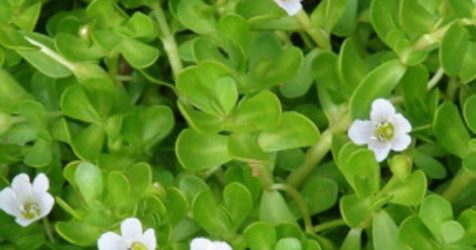
Adding unique plants to the aquarium can be pretty exciting. If you are tired of the staple green plants, this one is a good exception. The white, yellowish leaf adds a good contrast to the dark substrate and the surroundings of the aquarium.
Although the plant is quite versatile, it also requires consistent trimming every few weeks. The plant can grow up to one foot if not trimmed. However, once you trim the edges, it grows faster and at a healthier rate.
The plant initially has light green leaves, which fade and turn yellow as it grows. Also, it is a column feeding plant.
| Light level required | Low to moderate |
| Level of care | Easy |
| Compatibility | Small to moderate tanks |
19. American Waterweed (Elodea Canadensis)
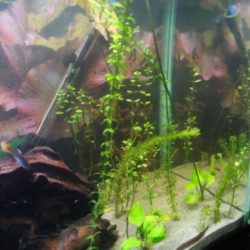
Like Hydrilla, American waterweed is a staple in several homes. The thick stalks with light green leaves propagate quickly in the tank and grow up to 3 feet. The small leaves grow off the side of the stem.
The plant is very versatile and can grow in different water conditions. Also, it grows as creepers, so you need to stalk its path using twines or threads. It is a column feeding plant as well. The best reason behind its popularity is because it produces a lot of oxygen in the tank, allowing better health for the fish in the tank.
| Light level required | Low |
| Level of care | Easy |
| Compatibility | Small to medium tanks |
20. Guppy Grass (Nahas Guadalupensis)
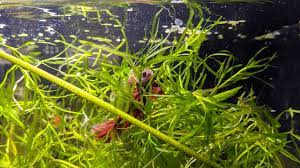
No, we aren’t talking about the fish. This works well with the breeding tanks, not just for the home aquariums, ideally for the smaller leaves and twisted stems. The network and web make it ideal for the eggs to hatch on and serve as a hiding spot.
The adaptability of the guppy grass is immaculate. It can pretty much thrive anywhere you put it in, from high to low light conditions. The changing lighting conditions contribute to the changing color of the leaves.
This is a column feeder and grows very quickly. This suggests that you must trim it every week to prevent it from overgrowing inside the tank. Ideally, the plant grows well in warm water conditions.
| Light level required | Low to moderate |
| Level of care | Easy |
| Compatibility | Breeding tanks |
FAQs
What aquarium plants do well in low light?
Several aquatic plants thrive in low light conditions, including Anubias, Java Moss, Java fern, Hydrilla, to name a few.
Can dwarf hair grass grow in low light?
Yes, dwarf hair grass thrives in low light conditions. It also needs low carbon dioxide levels and a well-fertilized substrate since it is not a water column feeder.
Are 6 hours of light enough for aquarium plants?
Ideally, aquarium plants won’t need over 8 hours of light exposure. So, leaving the aquarium light on for 6 hours is a pretty average timing and will do more than enough.
What is the easiest aquarium plant to keep?
If you aren’t well versed with tank maintenance and want to start small, versatile plants like moss and java fern are easy to maintain.
Can I put houseplants in my aquarium?
Yes and no. Not every houseplant is compatible with aquarium water. Technically, we’d recommend knowing which ones are compatible and then transferring them into the water. Houseplants like Pothos, Spider plants, etc., work well in the aquarium.
Conclusion
A great mix of these easy-to-grow low light plants will help a beginner aquarists develop a vast, long-lasting, low-cost low-light planted aquarium that will provide a calming effect and pleasure for years to come.
With all of this information, you can now enjoy and grow your complex aquarium with a combination of simplicity of this inspiring underwater paradise without all of the hassles of constant maintenance that comes with high-tech planted tanks.

4 thoughts on “20 Best Low Light Aquarium Plants”
good article,very helpful to start my aquascape. Thanks
I found yourinformation interesting and enlightening.
Thanks.
Thanks..this article was very helpful.
Wonderful news for all people starting a planted tank, success will keep them in the hobby and progress to more difficult plants in the future!!